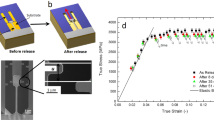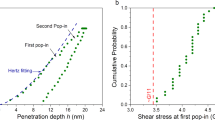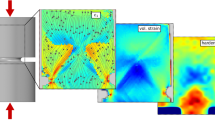Abstract
Metallic glasses have a very high strength, hardness and elastic limit. However, they rarely show tensile ductility at room temperature and are considered quasi-brittle materials1,2. Although these amorphous metals are capable of shear flow, severe plastic instability sets in at the onset of plastic deformation, which seems to be exclusively localized in extremely narrow shear bands ∼10 nm in thickness3,4,5,6,7,8,9,10,11,12,13. Using in situ tensile tests in a transmission electron microscope, we demonstrate radically different deformation behaviour for monolithic metallic-glass samples with dimensions of the order of 100 nm. Large tensile ductility in the range of 23–45% was observed, including significant uniform elongation and extensive necking or stable growth of the shear offset. This large plasticity in small-volume metallic-glass samples did not result from the branching/deflection of shear bands or nanocrystallization. These observations suggest that metallic glasses can plastically deform in a manner similar to their crystalline counterparts, via homogeneous and inhomogeneous flow without catastrophic failure. The sample-size effect discovered has implications for the application of metallic glasses in thin films and micro-devices, as well as for understanding the fundamental mechanical response of amorphous metals.
This is a preview of subscription content, access via your institution
Access options
Subscribe to this journal
Receive 12 print issues and online access
$259.00 per year
only $21.58 per issue
Buy this article
- Purchase on Springer Link
- Instant access to full article PDF
Prices may be subject to local taxes which are calculated during checkout




Similar content being viewed by others
References
Schuh, C. A., Hufnagel, T. C. & Ramamurty, U. Mechanical behavior of amorphous alloys. Acta Mater. 55, 4067–4109 (2007).
Sergueeva, A. V., Mara, N. A., Branagan, D. J. & Mukherjee, A. K. Strain rate effect on metallic glass ductility. Scr. Mater. 50, 1303–1307 (2004).
Johnson, W. L. Bulk glass-forming metallic alloys: Science and technology. Mater. Res. Soc. Bull. 24, 42–56 (1999).
Pampillo, C. A. & Chen, H. S. Compressive plastic deformation of a bulk metallic glass. Mater. Sci. Eng. 13, 181–188 (1974).
Davis, L. A. & Yeow, Y. T. Flow and fracture of a Ni–Fe metallic glass. J. Mater. Sci. 15, 230–236 (1980).
Liu, C. T. et al. Test environments and mechanical properties of Zr-base bulk amorphous alloys. Metall. Mater. Trans. A 29, 1811–1820 (1998).
Lewandowski, J. J. & Lowhaphandu, P. Effects of hydrostatic pressure on the flow and fracture of a bulk amorphous metal. Phil. Mag. A 82, 3427–3441 (2002).
Yavari, A. R., Lewandowski, J. J. & Eckert, J. Mechanical properties of bulk metallic glasses. Mater. Res. Soc. Bull. (August 2007).
Hays, C. C., Kim, C. P. & Johnson, W. L. Microstructure controlled shear band pattern formation and enhanced plasticity of bulk metallic glasses containing in situ formed ductile phase dendrite dispersions. Phys. Rev. Lett. 84, 2901–2904 (2000).
Zhang, Z. F., Eckert, J. & Schultz, L. Fatigue and fracture behavior of bulk metallic glass. Metall. Mater. Trans. A 35, 3489–3498 (2004).
Inoue, A., Zhang, W., Tsurui, T., Yavari, A. R. & Greer, A. L. Unusual room-temperature compressive plasticity in nanocrystal-toughened bulk copper-zirconium glass. Phil. Mag. Lett. 85, 221–229 (2005).
Zhang, Z. F., Zhang, H., Pan, X. F., Das, J. & Eckert, J. Effect of aspect ratio on the compressive deformation and fracture behaviour of Zr-based bulk metallic glass. Phil. Mag. Lett. 85, 513–524 (2005).
Bei, H., Xie, S. & George, E. P. Softening caused by profuse shear banding in a bulk metallic glass. Phys. Rev. Lett. 96, 105503 (2006).
Volkert, C. A., Cordero, N., Lilleodden, E. T., Donohue, A. & Spaepen, F. in Size Effects in the Deformation of Materials—Experiments and Modeling (eds Lilleodden, E., Besser, P., Levine, L. & Needleman, A.) (Mater. Res. Soc. Symp. Proc., Vol. 976E, Materials Research Society, Warrendale, 2007).
Spaepen, F. in Processing-Structure-Mechanical Property Relations in Composite Materials (eds Thilly, L., Moody, N. R., Misra, A., Anderson, P. M. & Kumar, M.) (Mater. Res. Soc. Symp. Proc., Vol. 977E, Materials Research Society, Warrendale, 2007).
Zheng, Q., Cheng, S., Strader, J. H., Ma, E. & Xu, J. Critical size and strength of the best bulk metallic glass former in the Mg–Cu–Gd ternary system. Scr. Metall. 56, 161–164 (2007).
Uchic, M. D., Dimiduk, D. M., Florando, J. N. & Nix, W. D. Sample dimensions influence strength and crystal plasticity. Science 305, 986–989 (2004).
Schroers, J. & Johnson, W. L. Ductile bulk metallic glass. Phys. Rev. Lett. 93, 255506 (2004).
Das, J. et al. “Work-hardenable” ductile bulk metallic glass. Phys. Rev. Lett. 94, 205501 (2005).
Liu, Y. H. et al. Super plastic bulk metallic glasses at room temperature. Science 315, 1385–1388 (2007).
Zhang, Y., Wang, W. H. & Greer, A. L. Making metallic glasses plastic by control of residual stress. Nature Mater. 5, 857–860 (2006).
Bae, D. H., Lee, S. W., Kwon, J. W., Yi, S. & Park, J. S. Deformation behavior of Zr–Al–Cu–Ni–Sn metallic glasses. J. Mater. Res. 21, 1305 (2006).
Li, Q. & Li, M. Molecular dynamics simulation of intrinsic and extrinsic mechanical properties of amorphous metals. Intermetallics 14, 1005–1010 (2006).
Chen, M., Inoue, A., Zhang, W. & Sakurai, T. Extraordinary plasticity of ductile bulk metallic glasses. Phys. Rev. Lett. 96, 245502 (2006).
Wu, F. F. et al. Multiplication of shear bands and ductility of metallic glass. Appl. Phys. Lett. 90, 191909 (2007).
Conner, R. D., Johnson, W. L., Paton, N. E. & Nix, W. D. Shear bands and cracking of metallic glass plates in bending. J. Appl. Phys. 94, 904–901 (2003).
Wright, T. W. & Ockendon, H. A scaling law for the effect of inertia on the formation of adiabatic shear bands. Int. J. Plasticity 12, 927–934 (1996).
Argon, A. S. & Kou, H. Y. Plastic flow in a disordered bubble raft (an analog of a metallic glass). Mater. Sci. Eng. 39, 101–109 (1979).
Spaepen, F. A microscopic mechanism for steady state in homogeneous flow in metallic glasses. Acta Metall. 25, 407–415 (1977).
Ashby, M. F. & Greer, A. L. Metallic glasses as structural materials. Scr. Mater. 54, 321–326 (2006).
Schuh, C. A., Lund, A. C. & Nieh, T. G. New regime of homogeneous flow in the deformation map of metallic glasses: Elevated temperature nanoindentation experiments and mechanistic modeling. Acta Mater. 52, 5879–5891 (2004).
Wang, Y. M., Li, J., Hamza, A. V. & Barbee, T. W. Jr. Ductile crystalline-amorphous nanolaminates. Proc. Natl Acad. Sci. 104, 11155–11160 (2007).
Hobbs, L. W. Introduction to Analytical Electron Microscopy Ch. 17 (Plenum, New York, 1979).
Hajlaoui, K. et al. Shear delocalization and crack blunting of a metallic glass containing nanoparticles: In-situ deformation in TEM analysis. Scr. Mater. 54, 1829–1834 (2006).
Acknowledgements
Financial support from the National Nature Science Foundation of China (Grant Nos 50125103, 50671104 and 50625103) and the ‘Hundred of Talents Project’ of the Chinese Academy of Science (CAS) are gratefully acknowledged. The authors were also part of the MANS research team, supported in part by CAS.
Author information
Authors and Affiliations
Corresponding author
Ethics declarations
Competing interests
The authors declare no competing financial interests.
Rights and permissions
About this article
Cite this article
Guo, H., Yan, P., Wang, Y. et al. Tensile ductility and necking of metallic glass. Nature Mater 6, 735–739 (2007). https://doi.org/10.1038/nmat1984
Received:
Accepted:
Published:
Issue Date:
DOI: https://doi.org/10.1038/nmat1984
This article is cited by
-
Elemental partitioning-mediated crystalline-to-amorphous phase transformation under quasi-static deformation
Nature Communications (2024)
-
Machine learning modeling for the prediction of plastic properties in metallic glasses
Scientific Reports (2023)
-
Substantially enhanced homogeneous plastic flow in hierarchically nanodomained amorphous alloys
Nature Communications (2023)
-
Size-dependent deformation behavior in nanosized amorphous metals suggesting transition from collective to individual atomic transport
Nature Communications (2023)
-
Fabrication of stainless-steel microfibers with amorphous-nanosized microstructure with enhanced mechanical properties
Scientific Reports (2022)



